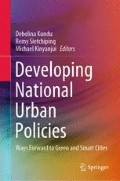Abstract
India is characterised by low level and rate of urbanisation. In the past decade, rural–urban reclassification was a major factor contributing to urbanisation. Indian urban structure is top heavy, with almost three-fourths of the urban population concentrated in the metropolitan and Class I cities and UAs. The metropolitan and Class I cities are better endowed in terms of amenities and services as compared to the small towns. Through the 74th Amendment (1992), urban local bodies were sought to be provided with greater responsibilities and funds for urban development. However, this decentralisation is yet to happen at the desired level. In the absence of a National Urban Policy, various programmes and missions for urban development functioned in silos. In the 1990s, the national five-year plans launched several programmes with private sector participation as ‘missions’—with clearly defined objectives, scopes, timelines, milestones, as well as measurable outcomes and service levels. These programmes, however, demonstrated a ‘big-city bias’. The much-acclaimed Smart Cities Mission, for instance, mainly focuses on retrofitting parts of cities by engaging special purpose vehicles (SPVs). A National Urban Development Framework (NUDF) has also been drafted to guide the process of urbanisation. In the light of these transformations, this chapter overviews India’s post-liberalisation urbanisation scenario; current urban development programmes and system of governance. It also overviews the basic tenets of the NUDF in light of meeting the sustainable agenda.
Access this chapter
Tax calculation will be finalised at checkout
Purchases are for personal use only
Notes
- 1.
The Class I cities are subdivided into three size-class categories: IA, IB and IC. Class IA are cities with a population above 5 million; Class IB cities are those with a population between 1 and 5 million, and Class IC cities are those with a population between 0.1 and 1 million (non-metropolitan Class I cities). Class IA and Class IB cities together define metropolitan cities.
- 2.
South Asia Development Matters, Leveraging Urbanization in South Asia, World Bank Report (2015).
- 3.
‘State of the world’s cities 2012/2013.’: Sustainable Development, UN. UN Habitat—For a Better Urban Future, 2012.
- 4.
- 5.
Article 243 ZD of the Constitution.
- 6.
Article 243 ZE of the Constitution.
References
ADB and Ministry of Urban Development. (2007). Report on benchmarking and data book of water utilities in India. Government of India.
Batra, L. (2009). A review of urbanization and urban policy in post-development India, Working Paper Series. Working Paper Number CSLG/WP/12, Centre for the Study of Law and Governance, Jawaharlal Nehru University, New Delhi.
Bhagat, R. B. (2014). Urban policies and programmes in India: Retrospect and prospect. Yojana,58, 4–8.
Fujita, M., Krugman, P., & Venables, A. (1999). The spatial economy: Cities, regions and international trade.
Government of India (2011). Report on Indian infrastructure and services. High Powered Expert Committee (HPEC).
Harris, J (2005). Political Participation, Representation and the Urban Poor: Findings from Research in Delhi. Economic and Political Weekly, 40(11), 1041–1054.
Henderson, V. (2000). How Urban Concentration Affects Economic Growth. World Bank Policy Research, Working Paper, (2326).
Jacob, J. (1984). Cities and the wealth of nations: Principles of economic life. New York, NY: Vintage.
Knowledge Wharton (2016). Leveraging the Internet of Things for Competitive Advantage, University of Pennsylvania. Retrieved from: http://knowledge.wharton.upenn.edu/article/leveraging-theinternet-of-things-for-competitive-advantage/
Kundu, et al. (2007). A Strategy Paper on ‘Migration and Urbanization in the Context of Development Dynamics, Governmental Programmes and Evolving Institutional Structure in India’, A Paper commissioned by United Nations Population Fund (UNFPA).
Kundu, A., Bagchi, S. & Kundu, D. (1999). Regional distribution of infrastructure and basic amenities in urban India: Issues concerning empowerment of local bodies. Economic and Political Weekly, 34(28), 1893–1906.
Kundu, D., & Samanta, D. (2011). Redefining the inclusive urban agenda in India. Economic and Political Weekly,46(5), 55–63.
Mahadevia, D. (2003). From Utopia to Pragmatism: The Paradoxes of Urban Development in India. Review of Development and Change, 8, 171–220.
Mathew, G. (2015). Investment challenge: Smart cities need smart funding options. The Indian Express, August 15. Retrieved from: https://indianexpress.com/article/india/india-others/investment-challenge-smart-cities-need-smart-funding-options/
McKinsey Global Institute. (2010). India’s Urban Awakening: Building Inclusive Cities. New Delhi: Sustaining Economic Growth.
MoHUPA, GoI. (2016). India Habitat III: National Report. Accessed from: http://mhupa.gov.in/writereaddata/1560.pdf.
Mookerji, N., & Taneja, M. (2014). Flexible PPP Pact to Woo Industry for Smart City. Available from http://www.business-standard.com/article/economy-policy/flexible-ppp-pact-to-woo-industry-for-smart-city-114091701235_1.html. Accessed March 18, 2016.
National Institute of Public Finance and Policy. (2009). India urban report: A summary assessment.
Planning Commission. (2011a). Mid TERM APPRAISAL OF ELEVENTH FIVE YEAR PLAN. New Delhi: Oxford University Press.
Planning Commission. (2011b). Report of the Working Group on Financing Urban Infrastructure. Government of India.
Planning Commission. (2012). Press Note on Poverty Estimates: 2009–10 and 2011–12. Government of India.
Press Information Bureau (2016). Prime Minister to launch smart city projects. Ministry of Housing and Urban Affairs (MoHUA), Government of India, June 23.
Registrar General of India (2011). Census of India. Government of India.
Sivaramakrishnan, K. C., Kundu, A., & Singh, B. N. (2007). Handbook of urbanization in India. New Delhi: Oxford University Press.
United Nations, Department of Economic and Social Affairs, Population Division. (2018). World urbanization prospects: The 2018 Revision. Online Edition.
UN-Habitat. (2013). State of the world cities 2012/2013: Prosperity of cities. New York, NY: UN-Habitat for better life.
World Bank Report. (2015). South Asia: Managing Spatial Transformation for Prosperity and Livability, Conference Edition, Washington DC, USA.
Acknowledgements
The author is grateful to Dr. Aparajita Ghatak (GIS specialist, NIUA) for the preparation of the GIS-based maps.
Author information
Authors and Affiliations
Corresponding author
Editor information
Editors and Affiliations
Rights and permissions
Copyright information
© 2020 Springer Nature Singapore Pte Ltd.
About this chapter
Cite this chapter
Kundu, D. (2020). Urbanisation in India: Towards a National Urban Policy Framework and Smart Cities. In: Kundu, D., Sietchiping, R., Kinyanjui, M. (eds) Developing National Urban Policies. Springer, Singapore. https://doi.org/10.1007/978-981-15-3738-7_4
Download citation
DOI: https://doi.org/10.1007/978-981-15-3738-7_4
Published:
Publisher Name: Springer, Singapore
Print ISBN: 978-981-15-3737-0
Online ISBN: 978-981-15-3738-7
eBook Packages: Social SciencesSocial Sciences (R0)

